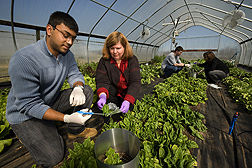Organic vs. Conventional Production
Measuring Microbes on Fresh Produce
Food safety is of paramount concern to today’s consumers and a guiding principle for producers of edible agricultural products. That’s why the Agricultural Research Service (ARS) is working to ensure that the U.S. food supply remains safe and abundant.
Food can become contaminated at many points during production, transport, storage, and handling—including in the home kitchen. But, food safety starts in farm fields and at animal-production locales. So a group of ARS scientists in Beltsville, Maryland, is looking at where microbes reside and how they move from the field to fresh organic produce. They’re also exploring how farm practices may be altered to hinder that movement.
Microbiologist Patricia Millner and others in ARS’s Food Safety Laboratory in Beltsville are studying the prevalence, diversity, and quantity of bacteria associated with organic—as compared to conventionally grown—fresh produce in Maryland, Virginia, West Virginia, and Pennsylvania. This undertaking requires a lot of groundwork before results can be obtained.
The researchers first had to determine which leafy greens would grow well in the Beltsville setting. Millner and her colleagues just finished those trials in so-called “high tunnels,” testing four cultivars of lettuce and four of spinach that had not been grown at the site before. High tunnels are plastic-covered hoophouses that provide protection from frost, wind, and rain while warming the soil inside and reducing numbers of insects, weeds, and predators. They enhance plant growth, yields, and quality of produce and reduce dependence on agrochemicals. High tunnels are gaining popularity among growers as a means of producing locally grown fresh produce beyond typical growing seasons.
“We needed to be reasonably sure that the leafy green cultivars selected would readily grow in the trial environment. There was a lot of variability in yield,” says Millner, “but we have chosen several spinach varieties that certainly seem to fit our criteria.”
Millner has also established outdoor research plots planted with the four spinach cultivars. Each cultivar is planted in two sections of an organically managed plot and two sections of a conventionally managed plot, all on the same type of sandy loam soil.
Finally, the produce and the soil will be inoculated with harmless bacteria that respond very similarly to human pathogenic strains of Salmonella and Escherichia coli O157:H7. The researchers will look at bacteria survival rates on leaves and in soil. “Because these studies will take place on open fields at Beltsville, it’s important to use only those microbes that won’t cause human illness,” explains Millner.
“Another aim is to determine and compare the colonization and survival of bacterial pathogens carried in polluted water, compost extracts, and manure sources during production of selected organic and conventional produce.”
There is another player in the movement of microbes between soil and produce: insects. Researchers will be looking at the Colorado potato beetle’s role in spreading bacterial pathogens. The team is interested in determining whether this resilient pest with a voracious appetite carries the bacterial pathogens from one plant to another. “We plan to compare the extent of the beetle’s pathogen transmission in both organic and conventionally grown produce,” says Millner.
“We will also conduct internalization studies, looking at the movement of E. coli into and within plants. This may allow us to find ways to reduce the incidence of bacterial pathogens in leafy green produce.”—By Sharon Durham, Agricultural Research Service Information Staff.
This research is part of Food Safety, an ARS national program (#108) described on the World Wide Web at www.nps.ars.usda.gov.
Patricia D. Millner is with the USDA-ARS Food Safety Laboratory, 10300 Baltimore Ave., Bldg. 001, BARC-West, Beltsville, MD 20705-2350; phone (301) 504-5631, ext. 449, fax (301) 504-8370.
"Organic vs. Conventional Production: Measuring Microbes on Fresh Produce" was published in the July 2008 issue of Agricultural Research magazine.








